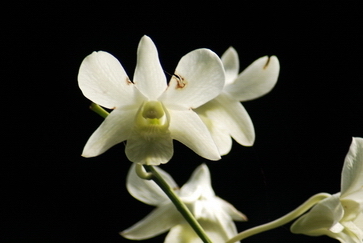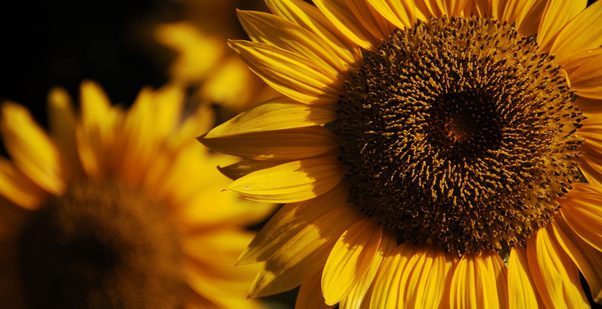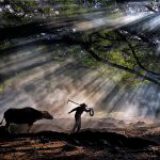Technology changes with time, but the fundamentals and recipes in photography remains. This article was first published in 2009, revised in 2018
Technology changes with time, but the fundamentals and recipes in photography remains. This article was first published in 2009, revised in 2018
“Can we conceive what humanity would be if it did not know the flowers?” – Maurice Maeterlinck
“Flowers seem intended for the solace of ordinary humanity.” – John Ruskin
“Flowers… are a proud assertion that a ray of beauty out-values all the utilities of the world.” – Ralph Waldo Emerson, 1844
“In friendship’s fragrant garden, There are flowers of every hue. Each with its own fair beauty, And its gift of joy for you.” – Friendship’s Garden
Flowers have been one of the most effective subject to lift up the mood of individuals and are often portrayed in paintings, as aesthetic decorative item in the vases in the home and office, or in the form of framed photographic prints on the wall. In fact, it is hard not to see flowers or images of flowers in one’s daily normal life.
Handphone camera and DSLRs/Mirrorless cameras are good to use for photographing flower. For handphone cameras, one of the favoured approaches is to use the Macro mode and do close-ups of the flowers. For the DSLRs/Mirrorless camera users, there is a wide range of lenses notably the Macro lenses to photograph flowers. In my opinion, any good lenses can be used to photograph flowers depending on the approach.
The use of a tripod and a low ISO will be preferred to achieve good quality images with minimal camera shake but provided there is no wind which causes the flowers to sway about. Should there be wind, either we wait for the wind to subside or we have to use a faster shutter speed to freeze the flowers in motion.
In certain cases, the use of a small aperture in the range of f22 will be needed for deeper depth of field for overall clarity especially if you want the flowers and the background to be clear. An example will be; you would like the wild flowers in the foreground and the Himalayas mountains in the background to be clear. However, most of the time, photographers will prefer a bigger aperture for the background to be blurred out which will make the flowers more outstanding. As for Exposure mode, any of the four modes (Program, Aperture Priority, Shutter Priority and Manual) can be used based on the personal preference of the photographer as well as the effect which the photographer wants to achieve.
Below are some pointers that could prove useful and the application can be found in the following case studies:
- Time of day
- Natural Lighting: Backlight, Side Light
- Choosing the main flower to face you
- Play with Depth of Field
- Play with “Triangle”
- Colours
- Complement subject (such as waterfall etc)
- Keep it simple, clean background
- Prevent hotspot
- Full bloom and complete petals
- Soft effect
- With techniques like framing, reflection etc
- Mistakes to avoid
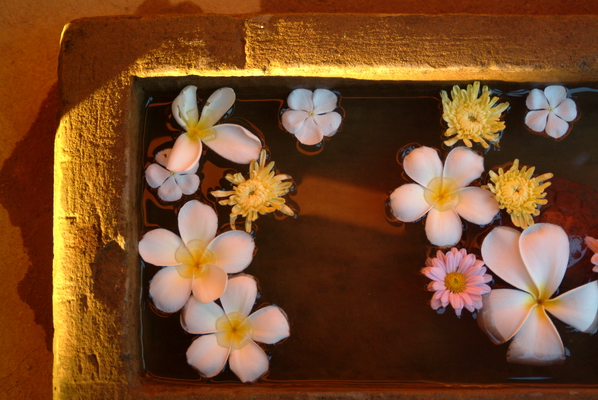
The pointers above are not exhaustive but if you bear them in mind and study the case studies below, you may find photographing flowers can be an enjoyable experience.
Time of day

Centre Weighted metering, Daylight White Balance, ISO400, Program Mode, Shutter speed 1/60s, Aperture f4, focal length set at 50mm
Early morning or late evening in non-cloudy days are the favourite time for photographers to photograph the flowers. This is the time when the sunlight is in a warm golden glow and the colours of the flowers will stand out very well. Hotspot is also very much minimized during this time as the sunlight is not harsh. Photographers usually avoid the noon sunlight to photograph the flowers as the lighting is too harsh.
Natural Lighting: Backlight, Side Light
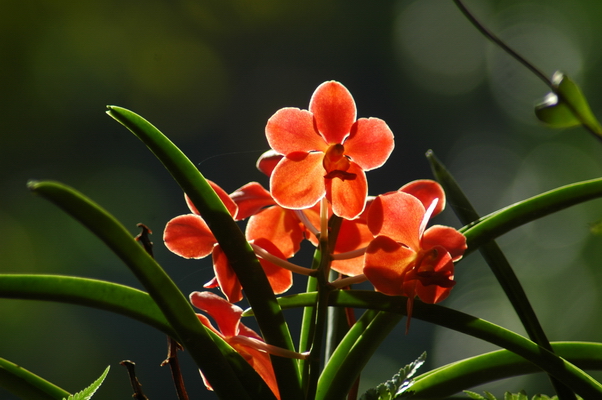
Centre Weighted Metering, Daylight White Balance, ISO200, Program Mode, Shutter speed 1/400s, Aperture f5.6, focal length set at 300mm
The above picture shows the backlight lighting up the flowers. The petals glow very nicely with the strong sunlight shining from the back of the flowers. One can also see the “rim light” all over the outline of the flower petals.
The flowers in the picture above are lit up by the sunlight from its side. Side lighting creates shadows and highlights, which can help to render the flowers in the photograph into a more “3D” effect, displaying the contours and shapes of the petals with the shadows and highlights. I did not have a telephoto lense with me hence I must move closer to the flowers, but I have to be cautious not to get too close or else I cannot focus (Need to maintain a minimum focus distance).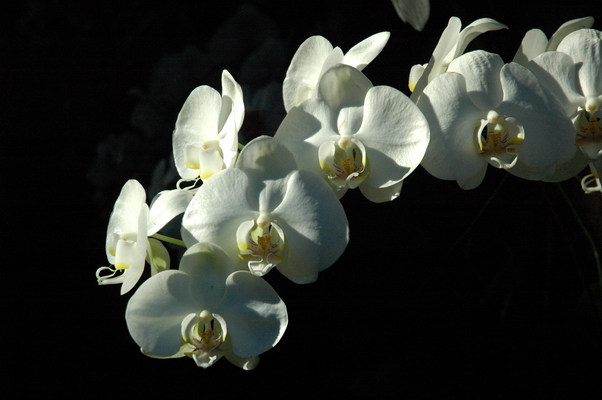
Centre Weighted Metering, Daylight White Balance, ISO200, Program Mode, Shutter speed 1/400s, Aperture f10, focal length set at 70mm
Choosing the main flower to face you
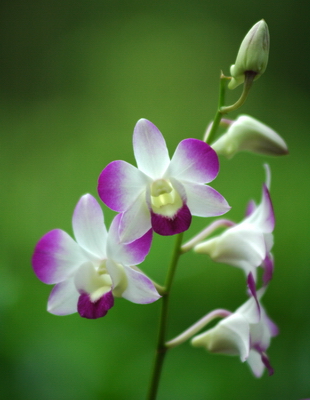
Centre Weighted metering, Daylight White Balance, ISO400, Program Mode, Shutter speed 1/200s, Aperture f2.8, focal length set at 200mm
It is certainly not visually interesting to photograph the back of the flowers all the time and you cannot see the flowers from the front with its glorious petals. Every photograph should always have a main subject and this is likewise for photographing flowers. You have to decide which flowers shall be your “main subject” and then photograph them facing you. I did not have a tripod with me when I took this photograph, hence I had to increase the ISO to ISO400 and use a big aperture of f2.8 with my fast lense.
Play with Depth of Field
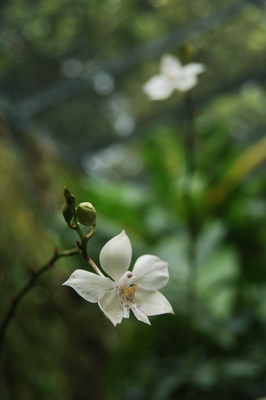
Centre Weighted Metering, Daylight White Balance, ISO320, Aperture Priority Mode, Shutter speed 1/160s, Aperture f4.8, focal length set at 50mm
A big aperture was used to render the background blur. This distinguishes the flower very well from its surroundings. This is especially useful in cases where one sees a bush of flowers of the same colour and one can have one flower in focus and the rest blurred out. I deliberately compose this photograph such that there is another similar flower in the background which is rendered out of focus. This approach shows the distance and depth.
Play with “Triangle”
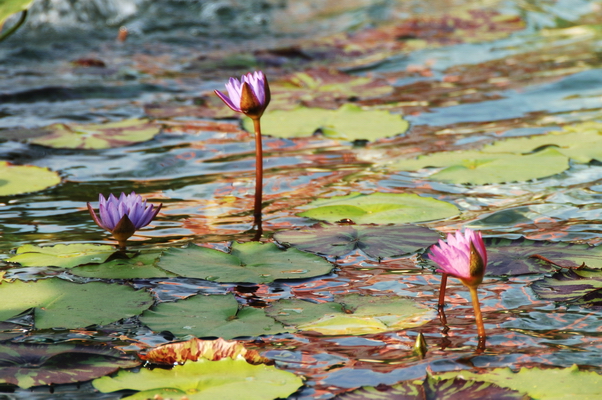 |
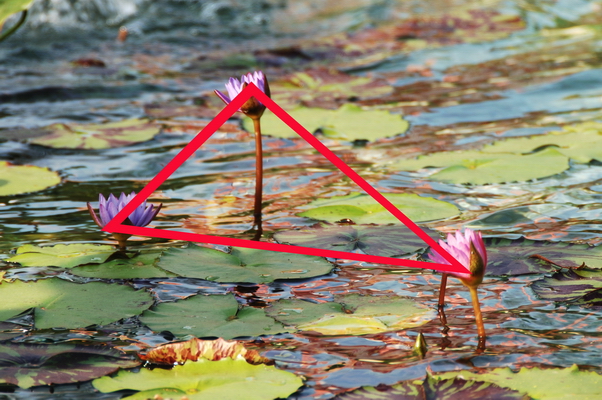 |
| This is one of the commonly used approaches where we play with a “triangle composition”. For the pictures above, the three flowers are composed in an angle such that they form a “triangle”. Try to practice in the pond in the gardens or in bushes where the flowers grow in stalks. Avoid cases where the flowers grow in bushes if you want to adopt this approach. | |
Colours
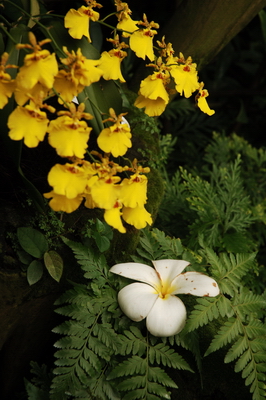
Centre Weighted metering, Daylight White Balance, ISO320, Aperture Priority Mode, Shutter speed 1/90s, Aperture f9, focal length set at 70mm
The white flower is used as my main subject but having it set against a dark green background somehow seems a bit dull and boring. I experimented adding in a bush of smaller but colourful flowers to add some life into the photograph. The yellow flowers are small and I position them in a corner of the frame, hence it is used to complement the white flower and not to compete with the white flower as the main subject.
Complement subject (such as water)
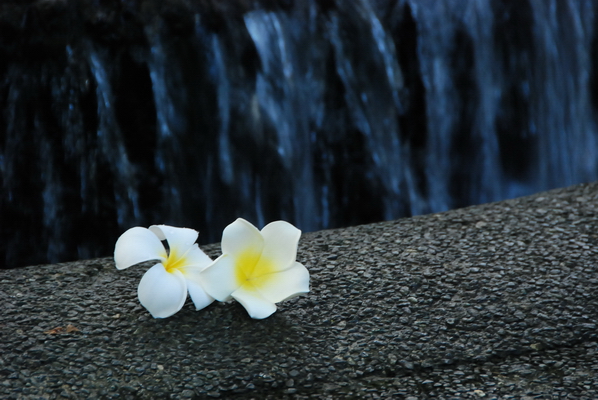
Centre Weighted Metering, Daylight White Balance, ISO400, Aperture Priority Mode, Shutter speed 1/15s, Aperture f11, focal length set at 170mm
Water is one of the features which blend in very well with flowers, since flowers need water, and the combination of flower and water often exhibits a “cooling” effect. In the photograph above, I used a tripod and a slower shutter speed to have the flowers in sharpness and the water in a mild blur with a slow shutter speed of 1/15s. If you refer to my previous article on “Water in Motion” in FOCUS issue 11 which you can download from the Nikon Singapore website, you can also experiment with using a slow shutter speed of 1 second and have the water in its soft blur effect.
Keep it simple, clean background
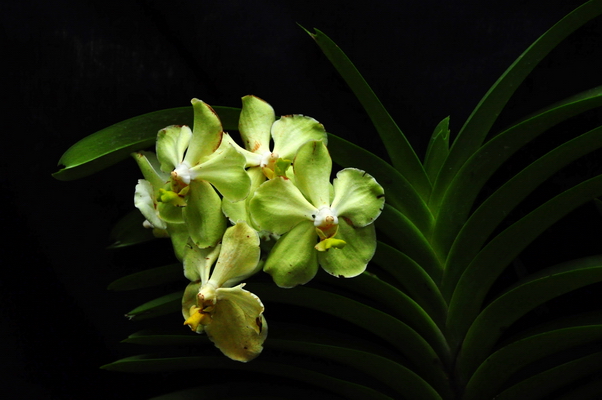
Matrix Metering, Daylight White Balance, ISO1000, Program Mode, Shutter speed 1/50s, Aperture f4.5, focal length set at 40mm
Somewhat looks like a calendar shot, one approach in photographing flower is to have a clean background in a uniform colour. One can choose a dark background or use a piece or dark material to place at the back of the flower to get this effect. I did not bring my tripod along and the lighting is not very strong, hence I had no choice but to use a higher ISO such as ISO1000. I rather have noise than camera shake. A shutter speed of 1/50s was achieved and this helped to minimized camera shake since my focal length was set at 40mm.
Prevent hotspot
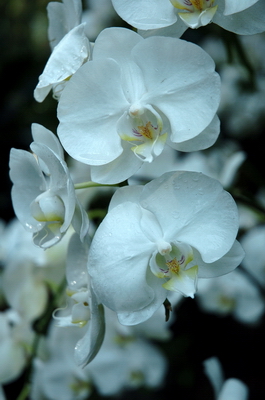
Matrix metering, Daylight White Balance, ISO200, Program Mode, Shutter speed 1/80s, Aperture f4.5, focal length set at 60mm
It is not easy photographing white flowers especially in sunny condition as the white petals often get “washed out” and result in hotspots if Neutral Density filters are not used. In flat light condition, this can be avoided. There is nothing wrong in photographing flowers in flat lighting condition (in the shade or cloudy day) as the resulting effect can also be nice.
Full bloom and complete petals
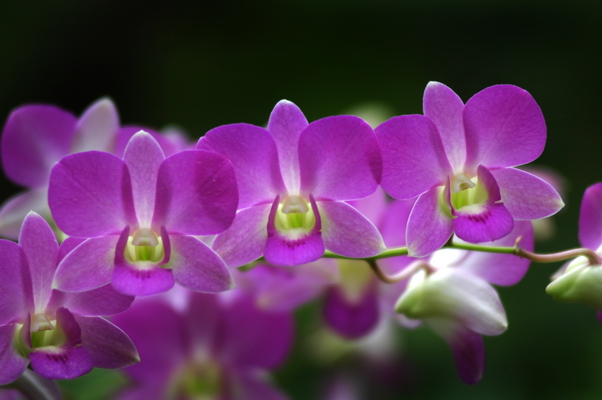
Matrix Metering, Daylight White Balance, ISO400, Program Mode, Shutter speed 1/125s, Aperture f2.8, focal length set at 170mm
Try to make it a point to photograph most if not all of the flowers in full bloom, though in some cases photographs of the flowers yet to emerge from its buds can be interesting. When the flowers are in full bloom, it is good to photograph the flowers with complete petals. Common issues are flowers with supposedly 5 petals are photographed with only 4 petals as 1 petal has fallen off.
Soft effect
 |
 |
| The above two photographs show the “before” and “after” the flower with and without a soft filter. Soft filters can be purchased from most camera shops and the filters come in different degree of softness. However, with the introduction of image manipulation software, this effect can be easily executed on a photograph of a flower and one can decide how soft one wants the flower to be by controlling the “softness” in the software. | |
With techniques like framing, etc
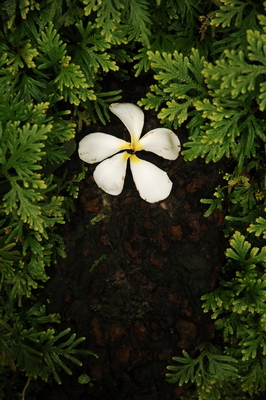
Centre Weighted metering, Daylight White Balance, ISO400, Aperture Priority Mode, Shutter speed 1/90s, Aperture f9, focal length set at 70mm
The use of different techniques to photograph the flowers can be used, such as the use of framing, perspective, reflection, pattern and so on. For the picture above, I place the white flower in the “frame” created by the leaves.
Mistakes to avoid
The following images are common mistakes which are often seen.
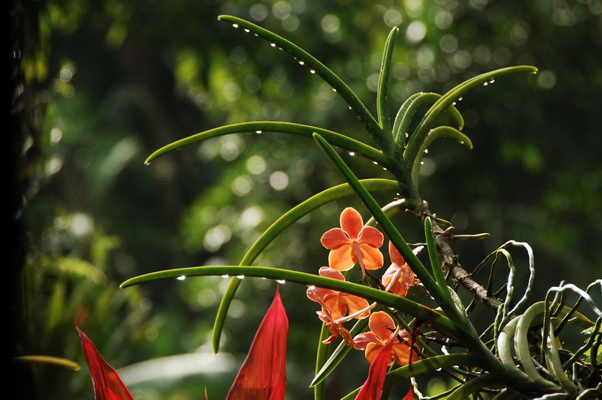
The background is very messy with many “white spots” which are distracting. This image can be cropped to place the attention on the flowers instead.
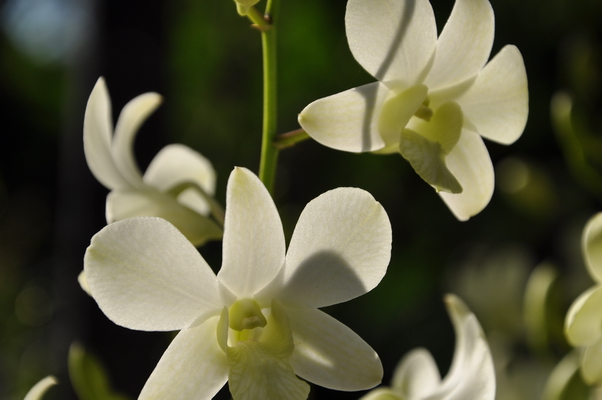
The petals are “chopped off” in the photograph. Try to avoid this.
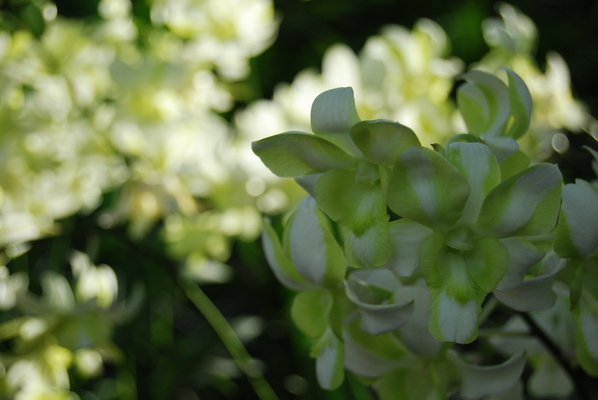
The flowers in the foreground are the main subject and in focus but the flowers in the background (which are thrown out of focus with the play of depth of field) appears to be dominating the photograph as it is very bright.
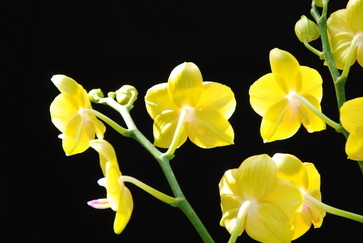
The flowers are photographed from the back. This is what many local photographers term as “shoot backside”.
